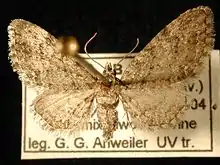Eupithecia columbiata
Eupithecia columbiata is a moth in the family Geometridae first described by Harrison Gray Dyar Jr. in 1904.[1][2] It is found in North America from eastern Newfoundland and Labrador to Vancouver Island, south to North Carolina in the east and Colorado in the west. The habitat consists of deciduous and mixed-wood forests and forest edges, as well as shrubby areas.
| Eupithecia columbiata | |
|---|---|
 | |
| Scientific classification | |
| Kingdom: | Animalia |
| Phylum: | Arthropoda |
| Class: | Insecta |
| Order: | Lepidoptera |
| Family: | Geometridae |
| Genus: | Eupithecia |
| Species: | E. columbiata |
| Binomial name | |
| Eupithecia columbiata (Dyar, 1904) | |
| Synonyms | |
| |
The wingspan is 13–24 mm. Adults are dull yellow-brown with darker grey-brown markings. Adults are on wing in spring, from mid April to mid June in Alberta.
The larvae feed on Rhamnus purshiana, Betula papyrifera, Salix, Prunus, Alnus, Cornus, Philadelphus, Ceanothus, Populus, Amelanchier and Acer species. The species overwinters in the pupal stage.[3]
References
- Yu, Dicky Sick Ki. "Eupithecia columbiata (Dyar 1904)". Home of Ichneumonoidea. Taxapad. Archived from the original on March 25, 2016.
- mothphotographersgroup
- Anweiler, G. G. (September 7, 2004). "Species Details: Eupithecia columbiata". University of Alberta Museums. E.H. Strickland Entomological Museum. Retrieved December 27, 2020.
| Wikimedia Commons has media related to Eupithecia columbiata. |
| Wikispecies has information related to Eupithecia columbiata. |
This article is issued from Wikipedia. The text is licensed under Creative Commons - Attribution - Sharealike. Additional terms may apply for the media files.
